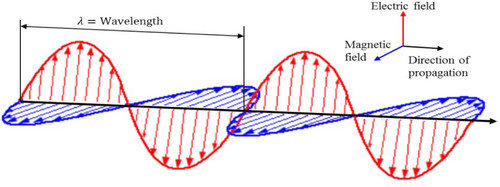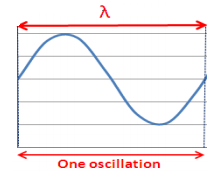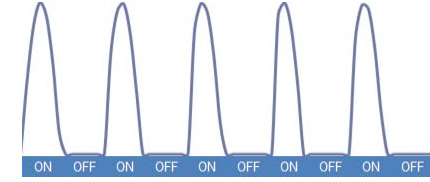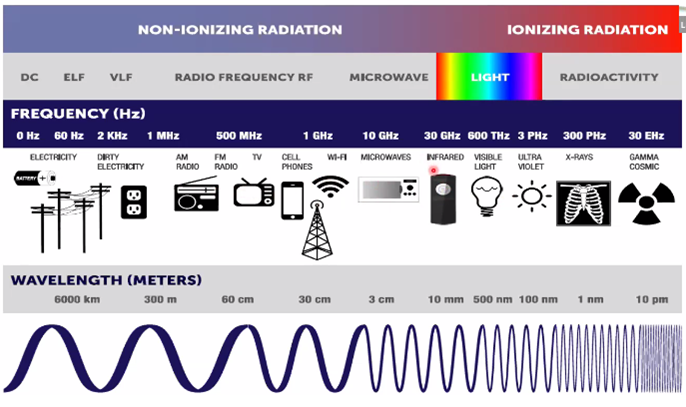Electromagnetic field (EMF) or electromagnetic radiation (EMR) is energy field that is all around us in the form of radio waves, microwaves, X-rays, gamma rays, etc. They can come form man-made sources, such as powerlines, wiring, electrical and electronic devices, cell phones and wireless devices, cell towers, etc., or natural sources such as the sunlight. The energy is transmitted in wave form, which can be characterized in terms of a wavelength λ or a frequency f.
They propagate in free space, carry energy, can carry information, travel in straight lines at the speed of light, can pass thru walls, and can be captured by placing a metal rod, a loop, or a parabolic metal dish (horn) in its path. EMF has two components: electric field and magnetic field.
Electric Field (E-field)
The electric field is a force on electrically charged objects. When a wire has voltage, it generates electric field in the surrounding air. No active current flow is needed to have electric field. In other words, the appliance or the light bulb at the end of the wire could be turned off and there would still be electric field as long as there is voltage.
Static electrical charges produce an electric field while charges in motion produce a magnetic field.
Electric field is described in Volts/meter (V/m).
Magnetic Field (M-field)
Magnetic fields exert deflective forces on moving electric charges. Magnetic field requires active current flow. When the appliance or the light bulb at the end of the air is turned on, current is flowing making a full circuit. That wire will be emanating magnetic field in the surrounding air across the length of the wire.
Magnetic field can be specified in either magnetic flux density or magnetic field strength.
How they look

EMF is invisible, but you can visualize them in the image on the right. Electric and magnetic field runs perpendicular to each other while flowing in the direction of the propagation.
Wavelength, Frequency, and Power Density

Each complete cycle or oscillation from the point of origination to its return is 1 wavelength (1 cycle).
Frequency refers to number of wavelengths or cycles per second. If it makes 2 cycles per second, then the frequency is 2 Hz.
Power density is the product of the electric field and the magnetic field (magnetic field strength). It describes the power per unit area perpendicular to the direction of propagation, usually expressed in terms of Watts per square meter (W/m2 ) or milliWatts per centimeter-squared (mW/cm2).
The lower the frequency, the longer the wavelength, the weaker the power density. The higher the frequency, the shorter the wavelength, the stronger the power density.
Residential powerlines in the US is 60 Hz, meaning it makes 60 oscillations per second, which is considered very low frequency. Its wavelength is very long – about 4,500 miles.
Your 900 MHz cordless phone would have frequency of 900,000 oscillations per second but wavelength would be only 42 inches long. A 28 GHz 5G phone communication will have frequency of 28 million per second with a wavelength of a mere 1.3 inch.
Radio Frequency (RF) Fields
A radiofrequency wave is a moving electromagnetic field that has velocity in the direction of travel and contains both electric field and magnetic field arranged at right angles to each other. RF field transmits and receives RF energy through free space. Examples are cell towers, cell phone, wireless devices, etc.
RF waves can propagate through various mediums including air. Their propagation depends on the frequency or wavelength as well as the absorbing characteristics of the medium. In a vacuum, the speed of RF wave is equal to the speed of light.
RF Antenna
An antenna is a device used to emit and receive radiofrequency (RF) waves. It transforms high frequency signals traveling on a conductor into electromagnetic (EM) waves in free space. The role of an RF antenna is to focus the initially generated waves into into narrow and intense RF beams. The focusing potential of the antenna is quantified by its Gain which is a measure of the proportion of the input power that is concentrated in a particular direction.
An antenna operates within a certain range of frequencies or bandwidth. The waves generated by an antenna have different properties at varying distances from the source, which are called nearfield and farfield.
Nearfield and Farfield
The near field is the electromagnetic field that starts at the RF generating source and extends to a distance of one wavelength from the antenna.
The farfield is located beyond the near field. In the far field, the measurement of only one quantity is enough (E-field, M-field, or power density). The other quantities can be calculated by means of equation.
Radio Frequency Transmission Types
RF emitters transmit their signals in either Continuous Wave mode or Pulsed Wave mode.
In Continuous Wave mode, the waves are emitted in a continuous command, having no alteration in the wave. These are successive oscillations that are identical. The power output of a continuous system is expressed in terms of average power.
In a Pulsed Wave mode, the waves are emitted in short pulses repeated at regular intervals. The output of a pulsed system is expressed in terms of peak power. These waves are altered by modulation, meaning some characteristic of the wave is varied. There are several types of modulations as described below.
Pulse modulation

Waves are emitted in short pulses. In other words, RF energy is rapidly switched ON and OFF. For example, Global System for Mobile (GSM) technology uses eight slots. A GSM phone will only be transmitting 1/8th of the time. Other examples are keyless entry, radar for airports, ships, speed detection, military, satellites, etc.
Amplitude modulation

RF waves are continuously emitted but with changing energy (amplitude). Example: AM radio.
Frequency modulation

These are RF waves that are constantly emitted and have constant amplitude but have change in frequency in small amounts. Examples are FM radio, data and fax modems, seismic prospecting, newborn EEG seizure monitoring device, etc.
Electromagnetic Spectrum
The electromagnetic spectrum is the range of frequencies and their respective wavelengths and photon energies coming from various man-made and natural sources discussed above. It is basically the entire range of light that exists, from visible light to wavelengths that eyes cannot perceive.

Is EMF harmful to our health?
The power and the wireless industry are among the largest in the world, having considerable lobbying and wielding power over governments. They downplay the effects of EMF on health calling it “controversial” or lacking “conclusive evidence”. Adverse health effects, however, are well documented in many studies conducted by objective scientists, and these studies are growing with the cases of modern illnesses rising that were not seen in the past.
These technologies are still relatively new and their health impact on biological forms are not yet fully understood. It might be many decades before we can fully ascertain how it affects health. In some way, we are being used as guinea pigs while this technology is rapidly propagated and used. Read my posts on health impact of EMF.
Mitigation
Electric fields and radiofrequency radiations can be mitigated by using various shielding materials. Magnetic fields, however, penetrate everything and are extremely difficult to mitigate.
One way of mitigation is to shut off the power source. If you turn off the switch that supplies power to an appliance or lightbulb, then the wire that the switch controls will have no magnetic field since there is no active current flow. It will, however, still have electric field as the wire is still carrying voltage. But if you turn the circuit breaker off that supplies current to your bedroom, it will stop both electric and magnetic fields from the wiring in your bedroom since those wires will be dead having no voltage. You may still be in the path of some amounts of electric and magnetic fields coming from nearby rooms where circuits are still active.
Similarly, if you turn off your cell phone or wireless router, you will eliminate RF radiations coming from these sources. You could, however, still be in the path of RF radiations from nearby cell towers or a neighbor’s router on the other side of the wall. However, turning off your own devices will certainly help in significantly reducing the amount of indoor radiations.
Another excellent mitigation choice is distancing. Electric and magnetic fields from wiring and appliances fall off fast with distance. If your head is within 1 foot of a wall where there is active wire, you would be subject to significant amount of radiations. But moving just 8 feet away will drastically reduce the radiation.
What the safe distance is depends on the strength of the power source. For high voltage power lines, your house should be at least several hundred feet away from it, and ideally several hundred yards away.
I am a certified Building Biology Consultant and a certified Electromagnetic Radiation Specialist. To schedule an EMF assessment in your home or office, please click here or contact me at (301) 653-0056.

